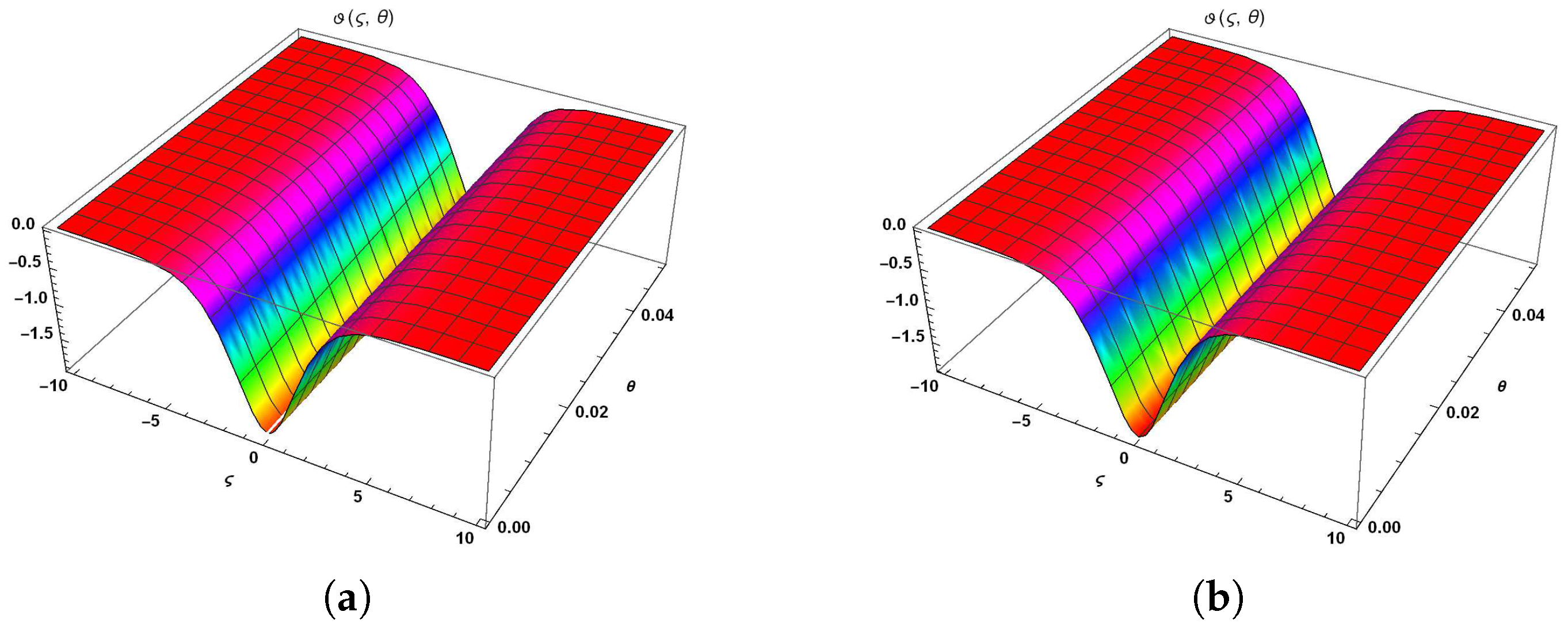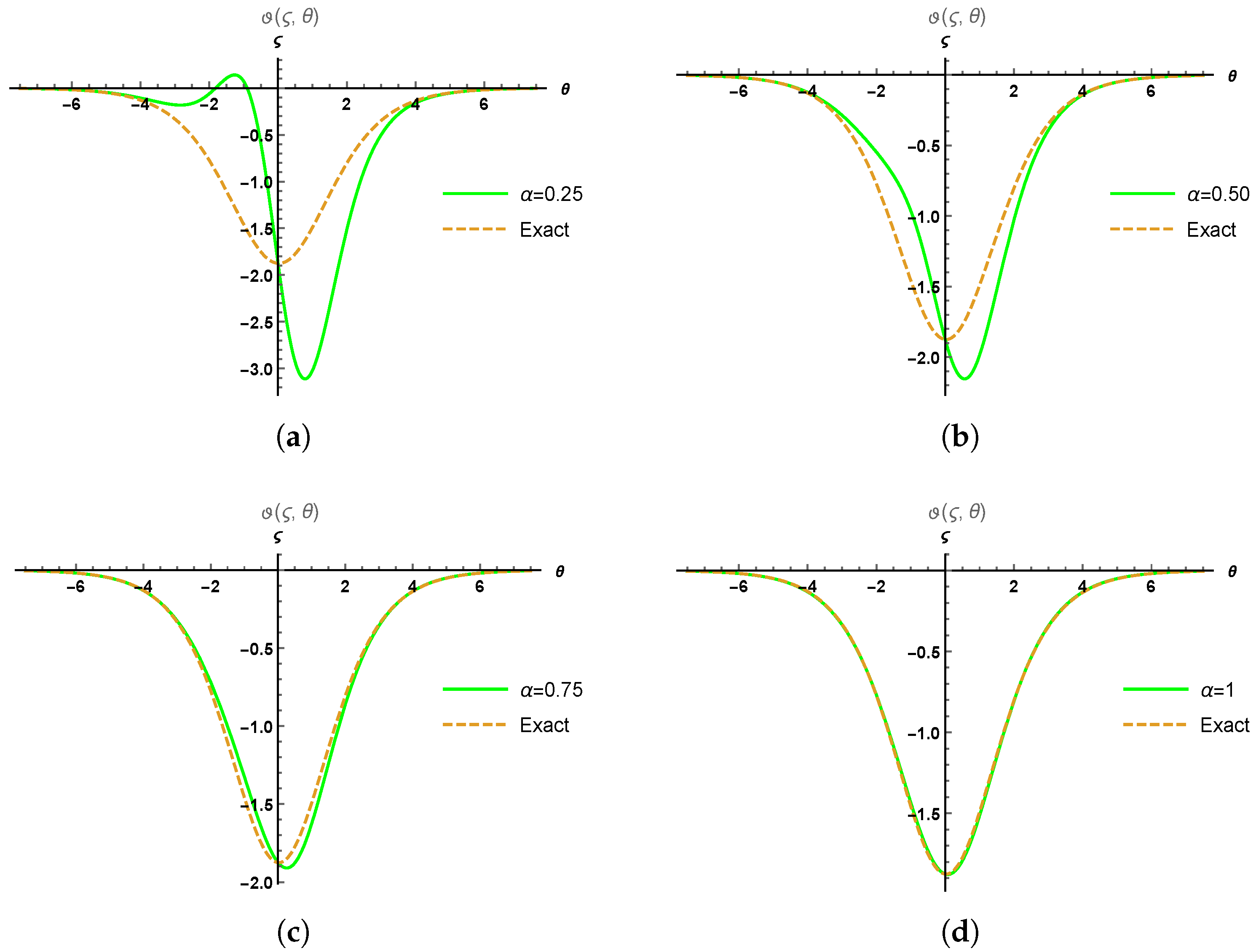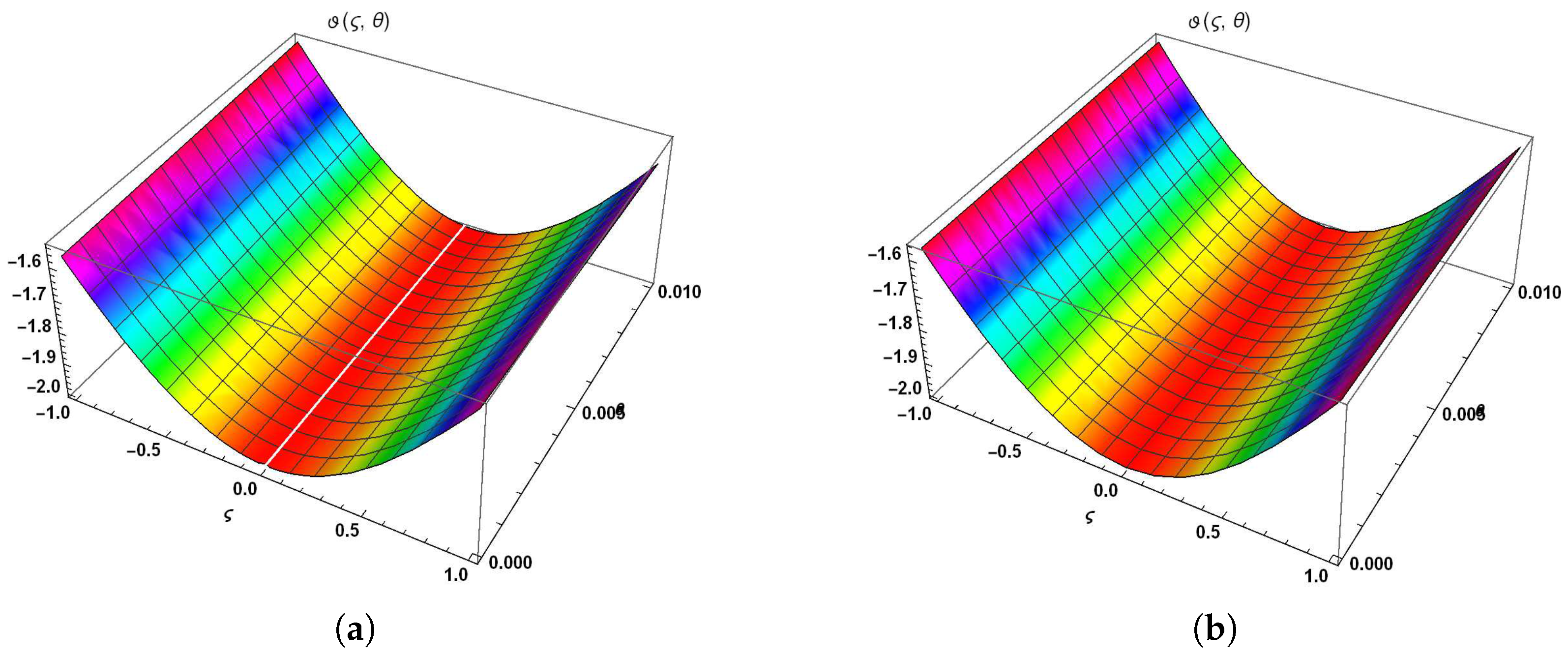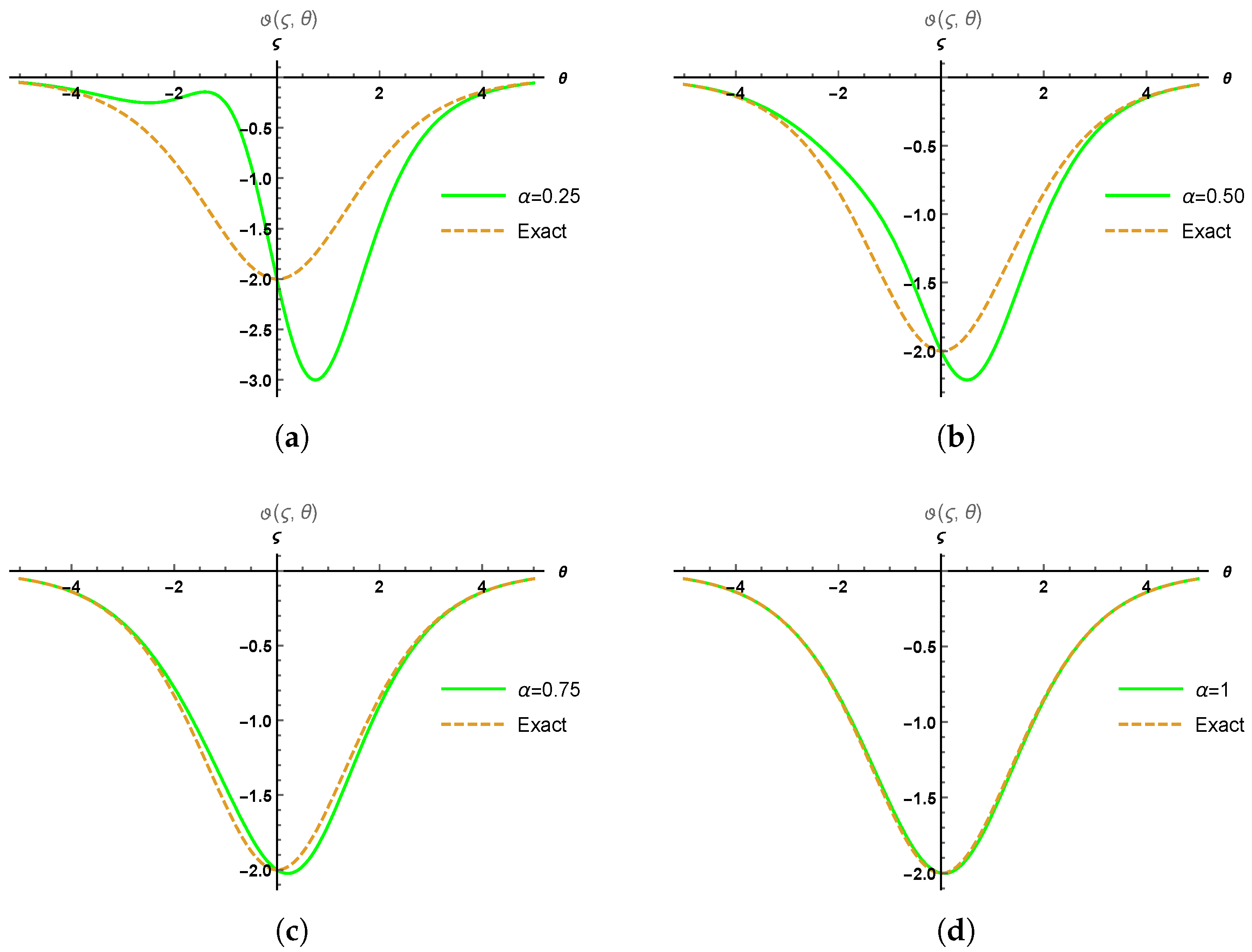A Computational Scheme for the Numerical Results of Time-Fractional Degasperis–Procesi and Camassa–Holm Models
Abstract
1. Introduction
2. Preliminary View
3. Fundamental Concept of HPTM
4. Numerical Problem
4.1. Example 1
4.2. Example 2
5. Results and Discussion
6. Conclusions
Author Contributions
Funding
Institutional Review Board Statement
Informed Consent Statement
Data Availability Statement
Acknowledgments
Conflicts of Interest
References
- Akdemir, A.O.; Butt, S.I.; Nadeem, M.; Ragusa, M.A. New general variants of Chebyshev type inequalities via generalized fractional integral operators. Mathematics 2021, 9, 122. [Google Scholar] [CrossRef]
- Abbas, M.I. Controllability and Hyers-Ulam stability results of initial value problems for fractional differential equations via generalized proportional-Caputo fractional derivative. Miskolc Math. Notes 2021, 22, 491–502. [Google Scholar] [CrossRef]
- Debnath, L. Recent applications of fractional calculus to science and engineering. Int. J. Math. Math. Sci. 2003, 2003, 3413–3442. [Google Scholar] [CrossRef]
- Atangana, A.; Baleanu, D. Caputo-Fabrizio derivative applied to groundwater flow within confined aquifer. J. Eng. Mech. 2017, 143, D4016005. [Google Scholar] [CrossRef]
- Fu, H.; Wu, G.C.; Yang, G.; Huang, L.L. Continuous time random walk to a general fractional Fokker–Planck equation on fractal media. Eur. Phys. J. Spec. Top. 2021, 230, 3927–3933. [Google Scholar] [CrossRef]
- Miller, K.S.; Ross, B. An Introduction to the Fractional Calculus and Fractional Differential Equations; Wiley: New York, NY, USA, 1993. [Google Scholar]
- Akgül, A.; Khoshnaw, S.A. Application of fractional derivative on nonlinear biochemical reaction models. Int. J. Intell. Netw. 2020, 1, 52–58. [Google Scholar]
- Kexue, L.; Jigen, P. Laplace transform and fractional differential equations. Appl. Math. Lett. 2011, 24, 2019–2023. [Google Scholar] [CrossRef]
- Pandir, Y.; Duzgun, H.H. New exact solutions of time fractional Gardner equation by using new version of F-expansion method. Commun. Theor. Phys. 2017, 67, 9. [Google Scholar] [CrossRef]
- Akbar, M.A.; Ali, N.H.M.; Islam, M.T. Multiple closed form solutions to some fractional order nonlinear evolution equations in physics and plasma physics. AIMS Math. 2019, 4, 397–411. [Google Scholar] [CrossRef]
- Prakash, A.; Kumar, M.; Baleanu, D. A new iterative technique for a fractional model of nonlinear Zakharov–Kuznetsov equations via Sumudu transform. Appl. Math. Comput. 2018, 334, 30–40. [Google Scholar] [CrossRef]
- Liu, T. Exact solutions to time-fractional fifth order KdV equation by trial equation method based on symmetry. Symmetry 2019, 11, 742. [Google Scholar] [CrossRef]
- Ziane, D.; Cherif, M.H. Variational iteration transform method for fractional differential equations. J. Interdiscip. Math. 2018, 21, 185–199. [Google Scholar] [CrossRef]
- Tang, B.; He, Y.; Wei, L.; Zhang, X. A generalized fractional sub-equation method for fractional differential equations with variable coefficients. Phys. Lett. A 2012, 376, 2588–2590. [Google Scholar] [CrossRef]
- Goswami, A.; Singh, J.; Kumar, D.; Gupta, S.; Sushila. An efficient analytical technique for fractional partial differential equations occurring in ion acoustic waves in plasma. J. Ocean. Eng. Sci. 2019, 4, 85–99. [Google Scholar] [CrossRef]
- Fu, H.; Wu, G.C.; Yang, G.; Huang, L.L. Fractional calculus with exponential memory. Chaos Interdiscip. J. Nonlinear Sci. 2021, 31, 031103. [Google Scholar] [CrossRef] [PubMed]
- Wazwaz, A.M. Solitary wave solutions for modified forms of Degasperis–Procesi and Camassa–Holm equations. Phys. Lett. A 2006, 352, 500–504. [Google Scholar] [CrossRef]
- Liu, Z.; Ouyang, Z. A note on solitary waves for modified forms of Camassa–Holm and Degasperis–Procesi equations. Phys. Lett. A 2007, 366, 377–381. [Google Scholar] [CrossRef]
- Kamdem, J.S.; Qiao, Z. Decomposition method for the Camassa–Holm equation. Chaos Solitons Fractals 2007, 31, 437–447. [Google Scholar] [CrossRef]
- Behera, R.; Mehra, M. Approximate solution of modified camassa–holm and degasperis–procesi equations using wavelet optimized finite difference method. Int. J. Wavelets Multiresolution Inf. Process. 2013, 11, 1350019. [Google Scholar] [CrossRef]
- Dubey, V.P.; Kumar, R.; Singh, J.; Kumar, D. An efficient computational technique for time-fractional modified Degasperis–Procesi equation arising in propagation of nonlinear dispersive waves. J. Ocean. Eng. Sci. 2021, 6, 30–39. [Google Scholar] [CrossRef]
- Yousif, M.A.; Mahmood, B.A.; Easif, F.H. A New Analytical Study of Modified Camassa–Holm and Degasperis–Procesi Equations. Am. J. Comput. Math. 2015, 5, 267. [Google Scholar] [CrossRef]
- Abdel Kader, A.; Abdel Latif, M. New soliton solutions of the CH–DP equation using lie symmetry method. Mod. Phys. Lett. B 2018, 32, 1850234. [Google Scholar] [CrossRef]
- He, J.H. Homotopy perturbation method: A new nonlinear analytical technique. Appl. Math. Comput. 2003, 135, 73–79. [Google Scholar] [CrossRef]
- He, J.H. Recent development of the homotopy perturbation method. Topol. Methods Nonlinear Anal. 2008, 31, 205–209. [Google Scholar]
- Zhang, B.g.; Li, S.y.; Liu, Z.r. Homotopy perturbation method for modified Camassa–Holm and Degasperis–Procesi equations. Phys. Lett. A 2008, 372, 1867–1872. [Google Scholar] [CrossRef]
- Qayyum, M.; Ismail, F.; Ali Shah, S.I.; Sohail, M.; El-Zahar, E.R.; Gokul, K. An Application of Homotopy Perturbation Method to Fractional-Order Thin Film Flow of the Johnson–Segalman Fluid Model. Math. Probl. Eng. 2022, 2022, 1019810. [Google Scholar] [CrossRef]
- Sinan, M.; Shah, K.; Khan, Z.A.; Al-Mdallal, Q.; Rihan, F. On Semianalytical Study of Fractional-Order Kawahara Partial Differential Equation with the Homotopy Perturbation Method. J. Math. 2021, 2021, 6045722. [Google Scholar] [CrossRef]
- Gupta, P.; Singh, M.; Yildirim, A. Approximate analytical solution of the time-fractional Camassa–Holm, modified Camassa–Holm, and Degasperis–Procesi equations by homotopy perturbation method. Sci. Iran. 2016, 23, 155–165. [Google Scholar]
- Baleanu, D.; Wu, G.C. Some further results of the laplace transform for variable–order fractional difference equations. Fract. Calc. Appl. Anal. 2019, 22, 1641–1654. [Google Scholar] [CrossRef]
- Khuri, S.A.; Sayfy, A. A Laplace variational iteration strategy for the solution of differential equations. Appl. Math. Lett. 2012, 25, 2298–2305. [Google Scholar] [CrossRef]
- Anjum, N.; He, J.H. Laplace transform: Making the variational iteration method easier. Appl. Math. Lett. 2019, 92, 134–138. [Google Scholar] [CrossRef]
- Nadeem, M.; Li, F. He–Laplace method for nonlinear vibration systems and nonlinear wave equations. J. Low Freq. Noise Vib. Act. Control. 2019, 38, 1060–1074. [Google Scholar] [CrossRef]
- Zhang, H.; Nadeem, M.; Rauf, A.; Hui, Z.G. A novel approach for the analytical solution of nonlinear time-fractional differential equations. Int. J. Numer. Methods Heat Fluid Flow 2020, 31, 1069–1084. [Google Scholar] [CrossRef]
- Kumar, D.; Singh, J.; Kumar, S. Numerical computation of fractional multi-dimensional diffusion equations by using a modified homotopy perturbation method. J. Assoc. Arab. Univ. Basic Appl. Sci. 2015, 17, 20–26. [Google Scholar] [CrossRef]




| at | at | Exact Solution () | Error | |
|---|---|---|---|---|
| 1 | −1.92812 | −1.51478 | −1.49154 | 0.02324 |
| 2 | −1.0006 | −0.806342 | −0.802536 | 0.003806 |
| 3 | −0.385726 | −0.342981 | −0.34657 | 0.003589 |
| 4 | −0.140106 | −0.133147 | −0.1357 | 0.002553 |
| 5 | −0.0509675 | −0.0499585 | −0.0511053 | 0.0011468 |
| 6 | −0.0186525 | −0.0185124 | −0.0189647 | 0.0004523 |
| 7 | −0.00684765 | −0.00682852 | −0.00699915 | 0.00017063 |
| 8 | −0.00251713 | −0.00251454 | −0.00257789 | 0.00006335 |
| 9 | −0.000925732 | −0.000825379 | −0.000948764 | 0.000023385 |
| 10 | −0.000340521 | −0.000340473 | −0.000349087 | 0.0000008614 |
| at | at | Exact Solution () | Error | |
|---|---|---|---|---|
| 1 | −2.0096 | −1.58015 | −1.60719 | 3.18734 |
| 2 | −1.04519 | −0.846361 | −0.856068 | 0.009707 |
| 3 | −0.406574 | −0.364698 | −0.36496 | 0.00262 |
| 4 | −0.1486654 | −0.14267 | −0.141879 | 0.000791 |
| 5 | −0.0542504 | −0.0537117 | −0.0532682 | 0.0004435 |
| 6 | −0.0198801 | −0.0199294 | −0.0197437 | 0.0001857 |
| 7 | −0.00730199 | −0.00735482 | −0.00728336 | 0.00007146 |
| 8 | −0.00268465 | −0.00270884 | −0.00268212 | 0.00002672 |
| 9 | −0.000987407 | −0.000996952 | −0.000983064 | 0.000009888 |
| 10 | −0.000363217 | −0.000366816 | −0.00036317 | 0.000003646 |
Publisher’s Note: MDPI stays neutral with regard to jurisdictional claims in published maps and institutional affiliations. |
© 2022 by the authors. Licensee MDPI, Basel, Switzerland. This article is an open access article distributed under the terms and conditions of the Creative Commons Attribution (CC BY) license (https://creativecommons.org/licenses/by/4.0/).
Share and Cite
Nadeem, M.; Jafari, H.; Akgül, A.; De la Sen, M. A Computational Scheme for the Numerical Results of Time-Fractional Degasperis–Procesi and Camassa–Holm Models. Symmetry 2022, 14, 2532. https://doi.org/10.3390/sym14122532
Nadeem M, Jafari H, Akgül A, De la Sen M. A Computational Scheme for the Numerical Results of Time-Fractional Degasperis–Procesi and Camassa–Holm Models. Symmetry. 2022; 14(12):2532. https://doi.org/10.3390/sym14122532
Chicago/Turabian StyleNadeem, Muhammad, Hossein Jafari, Ali Akgül, and Manuel De la Sen. 2022. "A Computational Scheme for the Numerical Results of Time-Fractional Degasperis–Procesi and Camassa–Holm Models" Symmetry 14, no. 12: 2532. https://doi.org/10.3390/sym14122532
APA StyleNadeem, M., Jafari, H., Akgül, A., & De la Sen, M. (2022). A Computational Scheme for the Numerical Results of Time-Fractional Degasperis–Procesi and Camassa–Holm Models. Symmetry, 14(12), 2532. https://doi.org/10.3390/sym14122532









